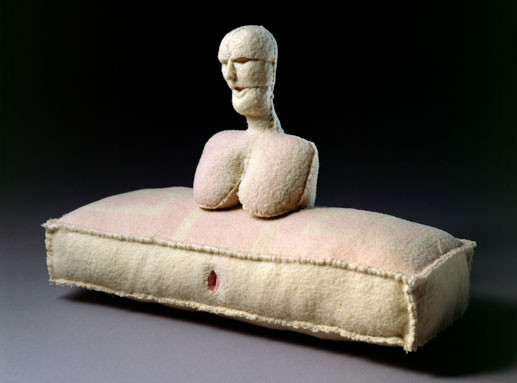Avatar und Atavismus
22 Aug - 08 Nov 2015
AVATAR UND ATAVISMUS
Outside der Avantgarde
22 August – 8 November 2015
Through juxtaposition and combination, the exhibition “Avatar und Atavismus: Outside der Avantgarde” reveals a phenomenon archetypically anchored in the art of the 1980s with the surprising appearance of heads, hands, and other body parts. This rebellion against the achievements of modernism—abstraction and conceptualism—includes well-known representatives of Western art from various generations. Since the transavantgarde movement around 1980, animistic elements have emerged in the form of the “dismembered body” (Jacques Lacan), the animal as an alter ego, and other codes of “savage thought” (Claude Lévi-Strauss). The close ties to outsider art cannot be overlooked. This phenomenon continues today, even if it has often been interpreted in different ways.
The exhibition features renowned artists with works between obsession, narrative, and the grotesque, which became possible in the wake of the postmodern turn after 1978. The first room with works from the “savage” decade features artists such Francesco Clemente, Walter Dahn, Martin Disler, and Jiří Georg Dokoupil. These are followed by works from Siegfried Anzinger alongside artists such as Antonius Höckelmann and Alfred Klinkan. In a kind of animistic chain, the following decade saw the invention of new avatars in the work of Franz West, Rosemarie Trockel, Günther Förg, Thomas Schütte, and Mike Kelley, such as West’s lemurs, Förg’s masks, and Trockel’s “Balaclava” knit face masks. What completely legitimizes these archetypes and only makes them truly visible today is the fact that these avatars are from various individuals from previous generations, led by Louise Bourgeois and Maria Lassnig with Georg Baselitz and Bruce Nauman, who demonstrated a similar attitude during the same period.
Well-known artists such as Sarah Lucas, Dana Schutz, Kai Althoff, Thomas Zipp, André Butzer, Andy Hope 1930, and John Bock continued this tendency after 2000, each interpreting it in their own way. Tal R and Jonathan Meese have reconstructed their castle installation MOR from 2005. The avatars of the young generation today combine with readymades and reflection on artistic media, as exemplified by the work of Neїl Beloufa and Eva Kot’átková.
The works by “outsider artists” were compiled by Pia Witzmann and Veit Loers directly from institutions in North Rhine-Westphalia and Italy. These include pieces by Georg Brinkschulte, Karl Burkhard, Giuseppe Curto, Giorgio Dorigo, Wilma Savio, Alfred Stief, and others from the Kunsthaus Kannen in Münster, Kunst-Praxis Soest e.V., MALzeitler in Duisburg, and ULSS 2 Feltre in Italy. They offer examples of the constant omnipresence of a reservoir of images inherent in all people, which only seldom reach the outside world against our prevailing rationality.
The exhibition was curated by Veit Loers with Gregor Jansen and Pia Witzmann. In October and early November 2015 it will overlap with Kasper König and Falk Wolf’s exhibition “The Shadow of the Avant-Garde” at the Museum Folkwang in Essen.
Outside der Avantgarde
22 August – 8 November 2015
Through juxtaposition and combination, the exhibition “Avatar und Atavismus: Outside der Avantgarde” reveals a phenomenon archetypically anchored in the art of the 1980s with the surprising appearance of heads, hands, and other body parts. This rebellion against the achievements of modernism—abstraction and conceptualism—includes well-known representatives of Western art from various generations. Since the transavantgarde movement around 1980, animistic elements have emerged in the form of the “dismembered body” (Jacques Lacan), the animal as an alter ego, and other codes of “savage thought” (Claude Lévi-Strauss). The close ties to outsider art cannot be overlooked. This phenomenon continues today, even if it has often been interpreted in different ways.
The exhibition features renowned artists with works between obsession, narrative, and the grotesque, which became possible in the wake of the postmodern turn after 1978. The first room with works from the “savage” decade features artists such Francesco Clemente, Walter Dahn, Martin Disler, and Jiří Georg Dokoupil. These are followed by works from Siegfried Anzinger alongside artists such as Antonius Höckelmann and Alfred Klinkan. In a kind of animistic chain, the following decade saw the invention of new avatars in the work of Franz West, Rosemarie Trockel, Günther Förg, Thomas Schütte, and Mike Kelley, such as West’s lemurs, Förg’s masks, and Trockel’s “Balaclava” knit face masks. What completely legitimizes these archetypes and only makes them truly visible today is the fact that these avatars are from various individuals from previous generations, led by Louise Bourgeois and Maria Lassnig with Georg Baselitz and Bruce Nauman, who demonstrated a similar attitude during the same period.
Well-known artists such as Sarah Lucas, Dana Schutz, Kai Althoff, Thomas Zipp, André Butzer, Andy Hope 1930, and John Bock continued this tendency after 2000, each interpreting it in their own way. Tal R and Jonathan Meese have reconstructed their castle installation MOR from 2005. The avatars of the young generation today combine with readymades and reflection on artistic media, as exemplified by the work of Neїl Beloufa and Eva Kot’átková.
The works by “outsider artists” were compiled by Pia Witzmann and Veit Loers directly from institutions in North Rhine-Westphalia and Italy. These include pieces by Georg Brinkschulte, Karl Burkhard, Giuseppe Curto, Giorgio Dorigo, Wilma Savio, Alfred Stief, and others from the Kunsthaus Kannen in Münster, Kunst-Praxis Soest e.V., MALzeitler in Duisburg, and ULSS 2 Feltre in Italy. They offer examples of the constant omnipresence of a reservoir of images inherent in all people, which only seldom reach the outside world against our prevailing rationality.
The exhibition was curated by Veit Loers with Gregor Jansen and Pia Witzmann. In October and early November 2015 it will overlap with Kasper König and Falk Wolf’s exhibition “The Shadow of the Avant-Garde” at the Museum Folkwang in Essen.

